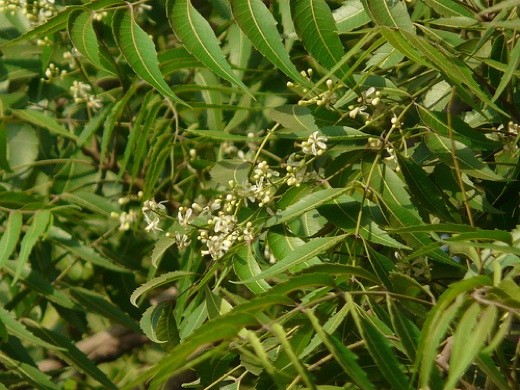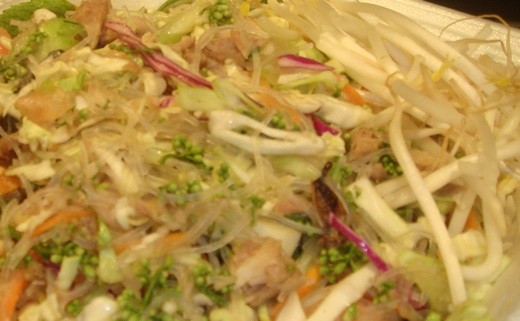Bitter is not a flavor generally loved by the American palate. Bitter is a flavor we cover up–with cream and sugar in our coffee, with sweeter, baby bitter greens in our salads. Elsewhere around the globe–and in many an ethnic restaurant in Orange County–bitter is a flavored loved and enjoyed along with salty, sweet, sour and umami: from the bite of wild greens in Italy and Greece to fried bitter melon in India to bitter beer in England. This isn't lost to the waiters in the Cambodian restaurants of Long Beach's Little Phnom Penh, who are always careful to warn non-Khmer customers about the intensity of flavor found in dishes made with the herb sdao. Whenever I have ordered the salad of fish and raw vegetables, garnished with a heavy sprinkling of sdao, I've received wary looks. “Have you had this before?” a waiter at Sohpy's in Signal Hill asked. After assuring him that I had and loved it, he told me “You're the only one!” At another Cambodian restaurant–Siem Reap, on Anaheim Street–a waitress, who had first suggested I order something else, conspicuously walked by to see the reaction to my first bite–a reaction you might expect to a thoroughly white diner ordering some offal dish, but not for a simple herb.

]
I find sdao to be delicious–its bitter, astringent taste is
well matched to the heat and acidity of much Cambodian food, which has
a somewhat similar flavor profile to Vietnamese and Thai food. The cold
fish and raw vegetable preparation is the dish I've found to best
represent the flavor, so for this week's edition of Dueling Dishes, two
sdao-laden salads from the aforementioned Sophy's and Siem Reap will be matched up.
But first, some background. Sdao was a mystery to me until the Internet told me it was the leaves from the tree known as neem in South Asia, its leaves used frequently in Ayur Vedic medicine and found in a wide variety of toiletries and beauty products from toothpaste to soap to skin creams. It thrives in sub-tropical climates, making it common throughout South and Southeastern Asia. The young, new shoots and flowers are the parts that are eaten, these more tender bits still providing the same blood purifying, good-for-you qualities as the tree's non-culinary byproducts.
Siem Reap's version of the dish features large chunks of flaky white fish mixed with cabbage, cucumber, sdao and raw slivers of incendiary green chilies–seeds and all–packing enough heat to burn any bitter flavor out of your mouth. Dressed with a good bit of lime and fish sauce, the dish has a wonderful balance of the whole array of flavors, including that unpredictable, intensely herbaceous bitter hit of sdao. The raw chilies are a serious hazard here, though. Getting a mouthful of one brings on a heat that goes far beyond a burning, tingling tongue–this bring sweat up behind the ears, raised eyebrows, the feeling of being stuck on a too-fast moving amusement park ride, not quite sure of how to slow down. Water, rice, ice are all of little help, but between the endorphin high brought about by that kind of heat and maybe cleaner blood flowing through your veins from the sdao, it is a dish that leaves you feeling practically scrubbed clean inside and out after finishing it. And this isn't some health food pitch about eating bland, tasteless food for health benefits, because this dish is packed with enough flavor and satisfying variety of textures–fish, raw vegetables, ground peanut garnish–to make it worth eating regardless. But brace yourself for the heat.

Compared to Siem Reap's four alarm fire of a salad, the Sophy's version of the dish seems almost tame, lacking any noticeable heat. But the dish is crafted with a bit more subtlety and nuance that make it notable in its own right. The fish is thoroughly chopped and combined with a mix of finely shredded crunch–carrots, cabbage green and red, bean sprouts–the refreshing flavor of mint cutting the aggressiveness of the sdao. Also included are glass noodles, adding another textural note and a bit of slippery coolness to the dish. All the ingredients are mixed with a similarly bracing dressing tasting of lime. Bitterness is a key player in this salad but, as at Siem Reap, the flavor works in accord with the others present, showing that when used in concert with the familiar salty, sweet, sour, etc., this less well-represented taste can bring a lot to a dish.
Who comes out ahead? Siem Reap's salad was certainly an experience to eat, but the overwhelming heat doesn't have me dying to order it again. The milder version from Sophy's had all of the taste and texture–and even some of the post-meal good feeling–of Siem Reap's, making it my favorite of the two. Sdao can be found throughout Cambodian cuisine–including a wonderful grilled catfish dish from Sophy's–so if you have a love for bitterness, you can easily seek out your fix Long Beach's Little Phnom Penh.
Siem Reap: 1810 E Anaheim St, Long Beach; (562) 591-7414
Sophy's Fine Thai and Cambodian Cuisine: 3240 E Pacific Coast Hwy, Long Beach; (562) 494-1763

